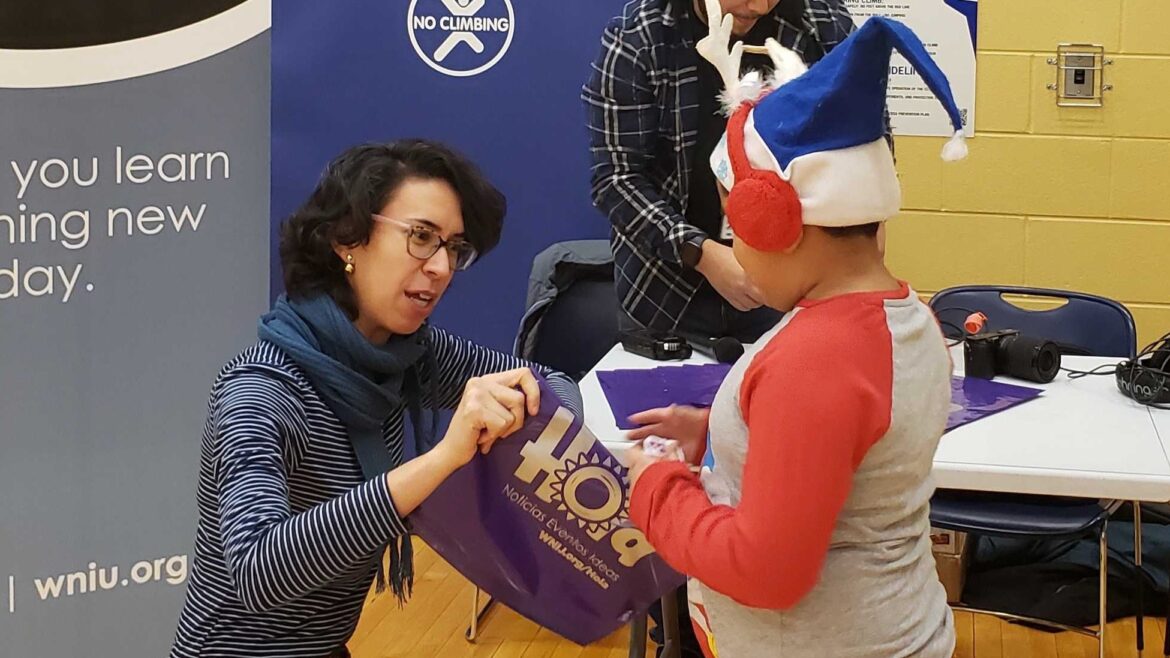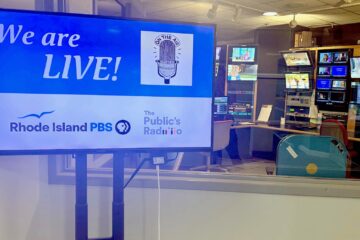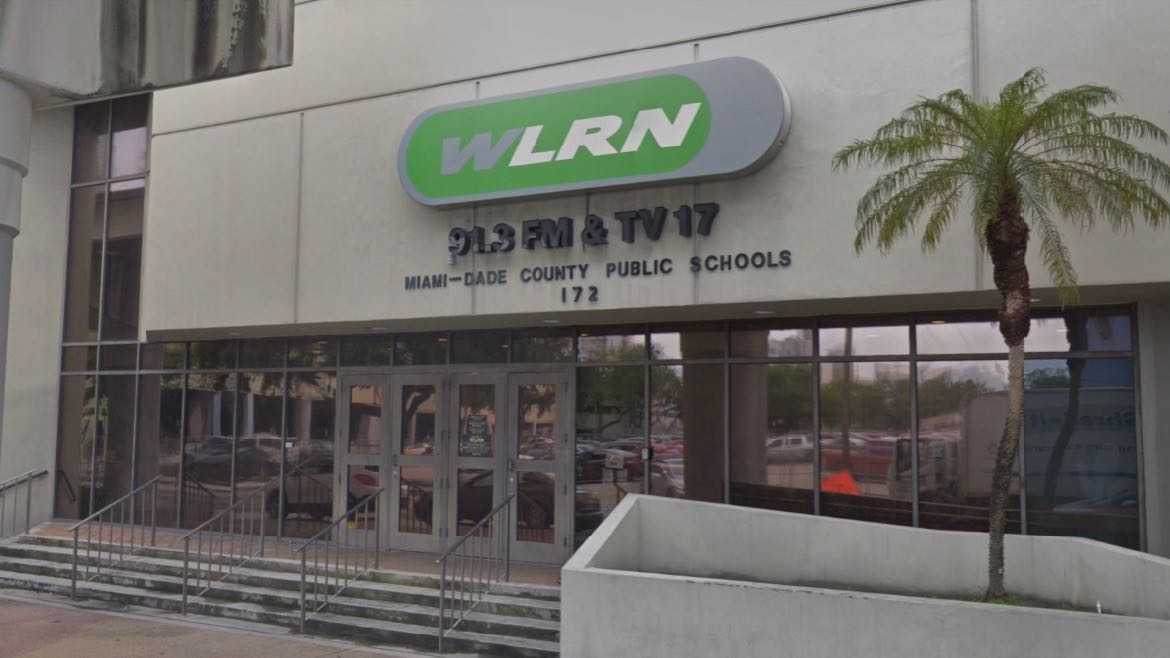Beyond translation: How WNIJ created content specifically for the Latinx community

WNIJ
WNIJ reporter Maria Gardner Lara speaks with a child at a holiday Posada event in Rochelle, Ill.
This article first appeared on the blog of America Amplified and is republished here with permission.
Launched in 2019, WNIJ’s Hola initiative engages decision-makers within multigenerational Latinx families and provides connections for Spanish-speakers in northern Illinois’ DeKalb County. In addition to news coverage that addresses issues relevant to the Spanish-speaking audience, Hola invites community members to submit essays, music, recipes and events that they later share on their website and social media pages. Through these engagement activities, Hola continues to build relationships with Spanish-speaking leaders, parents, community groups and workers. They told us about how the project came together.
What was the main objective of the initiative when it was originally launched?
Jenna Dooley, WNIJ news director: We originally launched with a much broader objective as “a new digital community with an events calendar, news, and an opinion series geared toward Spanish speakers of all levels in DeKalb County and beyond.”
While we still carry these elements into our project, we were encouraged to articulate a much clearer focus and objective in reaching new audiences through our cohort within the America Amplified initiative and the Poynter Digital Transformation Training.
How did the collaboration between America Amplified and your public media station help shape your public media coverage?
It created strong accountability to create a road map beyond our launch and support to fast-track some ideas or scrap others based on sharing knowledge with other stations who are already doing this important work. For example, part of our mission “to inform” includes the notion of combating misinformation. Through America Amplified, we met stations involved with Factchequeado, an initiative to counter mis- and disinformation in Spanish-speaking communities, and have been able to integrate their strong reporting network to share that content in audio and text with our bilingual audience.
We also reached out to a cohort station with success in developing a WhatsApp newsletter that helped us visualize where we want to start that process.
How is your station addressing local information needs through active listening and engagement?
We credit some of our new relationships with community food pantries and libraries to get our materials and staffers right in front of our targeted audience. Our objective is to connect resources, and being at community events allows us to fulfill that mission and build trust for the storytelling side of our work.
Our Report for America reporter Maria Gardner Lara also developed a connection with a bilingual school in Rochelle, Illinois, to provide the in-house music for a holiday Posada event open to the entire community. This was a successful interaction in terms of promoting our service by providing a service as well showing that we believe these are the events we hope to highlight that too often go under-reported.
Since then, we have had a couple of requests to provide AV/DJ services. As a news and music station, we hope to soon invest in mobile equipment to be able to engage in more community events that reach our target audience.
What challenges did your station face when trying to reach the Hispanic community?
Based on Census data, we know there is a growing and underserved population, but building audience from scratch is never automatic. Building relationships first with community-builders has been helpful, and then tapping into their already developed networks. We haven’t done that to the degree that I think is needed to grow our audience, but we have found that we are starting the process of identifying stakeholders who share our mission.
We also learned that “If you build it, they will come” isn’t really a strong strategy in an era of competing algorithms and news consumption silos. We need to share our content with folks who have strong connections and networks to make sure that our quality work gets seen.
How did your station partner with local organizations and community leaders to increase outreach efforts and build trust with the Hispanic community?
Finding the “navigators” in the community was a more obvious strategy than trying to find our audience simply through building content. Our full-time reporter listened to the needs she was hearing from folks in different areas who work with our targeted audience — from health care, legislation and policy, education, and moments of joy. Then she was able to connect with sources affected by those policies to be able to tell their stories.
What were the results of your station’s efforts to reach the Hispanic community?
From a content standpoint, we are looking to scale some of our successes from year one based on the lessons we have learned. We experimented. We saw wins and areas where we pivoted. We had projects we cut — a recipes Instagram didn’t take off and we couldn’t fine-tune the workflow to build audience there. We have projects we are expanding — a Facebook Live series with conversations on connecting with resources.
We struggled with translations and still rely on volunteer support to accomplish our weekly translation needs.
We are digging into our metrics to see which areas are getting attention as we prioritize our workflow. For example, we clearly see videos are trending much higher than sharing static posts, so we are investing in a new series called Hola Now featuring newsmakers in conversation with our bilingual hosts.
How does this case study demonstrate the importance of actively listening and engaging with all communities to better serve their information needs?
There is no audience without engagement. That is certainly true for a startup like this within our already established main brand. We were able to quickly create awareness of our existing audience for our launch, but that wasn’t our intended new audience, so we had to go beyond the station walls to grow audience. That takes work, vision, strategy, support and creativity.
Anything else you would like to add for other stations to consider?
If I had known what the last year would involve, I think I would have been pretty intimidated to take it on as a station strategy. Yet having the external support that we did has constantly re-enforced that this effort and mission is transformative. Having a strategy to reach a growing and significant population of the region is part of our overall station’s mission, so it really was in service to why we exist. Having this additional support to launch made it possible and saved us from years of trial and error.
In addition, we were able to secure several business and nonprofit underwriting contracts to help support the work in the new year. We set an outcome goal in our first year to raise $5,000 in underwriting revenue related to our Hola initiative. We exceeded that figure by our target deadline.
In order to accomplish that, we worked to make sure our corporate support team was clear on the mission of the project as well as the content goals so that they could articulate the initiative to potential funders. The contracts involve on-air announcements, digital sponsorships and social media mentions. We have been selling the underwriting at tiered levels for short-term and long-term contracts.
Additionally, we sought a local grant from the DeKalb County Community Foundation to assist with marketing and promotion efforts. This allowed us to print stickers and reusable tote bags as well as signs that appeared on buses that moved throughout the community. We are using local engagement efforts to get this branding out — food pantry events, community expos, bilingual story hours at the local libraries, and Latino parent groups.
Paola Marizán is a project manager and coach with America Amplified.






